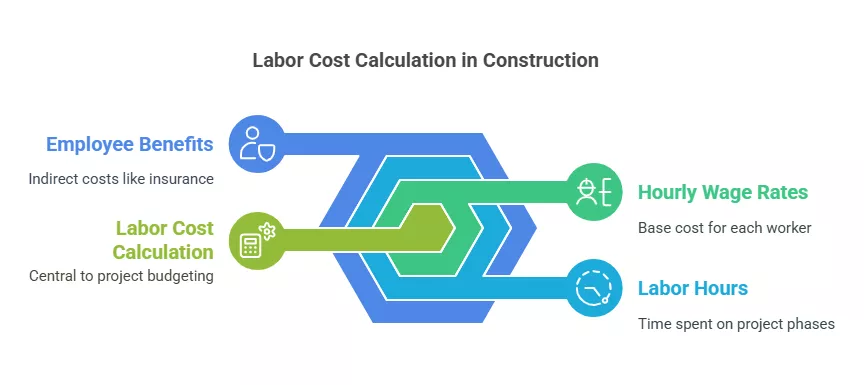Consider this scenario: You have devised a construction project plan, obtained all the required materials, drafted an adequate budget, and everything else relevant to starting the construction. Unexpectedly, midway through the building, you realize that the total costs have surpassed your initial budget. This can happen due to a myriad of reasons – in this case, it is likely because of labor cost underestimation. Depending on the type of construction project, labor costs can constitute anywhere from thirty to fifty percent of the budget, and it is easy to misestimate the required finances or miss out on additional expenses. This article will walk you through how to accurately incorporate labor costs into construction budgets while avoiding financial hurdles midway through the project.
1. Understanding Labor Costs in Construction
Before diving into the specifics of labor cost calculation, it’s important to first understand how labor costs impact your budget. Generally, labor is divided into two types:
- Direct Labor: These are the workers directly involved in physical tasks, like carpenters, electricians, and masons. These costs are the most straightforward to estimate.
- Indirect Labor: This refers to support roles, such as project managers, safety officers, and administrative staff, who are essential but not physically working on-site.
The budget can be impacted greatly by labor costs. For instance, in a residential construction project, labor might consume almost 40% of the total budget while commercial projects tend to spend even more. Being too cavalier with estimating labor expenses can throw your budget off-course, so take care with your estimates.
2. How to Accurately Calculate Labor Costs
To keep your construction project within budget, accurate labor cost calculation is essential. Here’s how to approach it:
- Hourly Wage Rates: Start by researching the hourly wages for each type of worker. Skilled workers (electricians, plumbers) typically command higher rates than general laborers. You can find wage data online or through local labor unions.
- Labor Hours: Estimate the total number of hours each worker will spend on the project. Break the project down into smaller phases (e.g., foundation, framing, finishing), and allocate labor hours accordingly. It’s crucial to factor in potential delays, such as bad weather or late material deliveries, which could increase labor hours.
- Employee Benefits: In addition to hourly wages, don’t forget about the indirect labor costs like workers’ compensation, health insurance, and other employee benefits. These costs can add 25% or more to the base wage, so they should be included in your calculations.

3. Construction Budgeting Tips for Labor Costs
Now that you know how to calculate labor costs, here are some construction budgeting tips to help you stay within your financial targets:
- Plan for Labor Efficiency: Scheduling labor effectively can help minimize wasted hours. Workers should be assigned tasks in a logical order, reducing downtime and maximizing productivity. A well-coordinated team can significantly lower your overall labor costs.
- Use Historical Data: Review data from previous projects to predict labor needs more accurately. Analyze how long similar tasks took in the past and use that information to refine your labor estimates.
- Factor in Overtime and Shift Premiums: Overtime or working during nights and weekends may be necessary for tight deadlines but can quickly inflate labor costs. Ensure your budget includes potential overtime rates and additional shift premiums.
- Include a Contingency Fund: No project goes exactly as planned. Unexpected delays, accidents, or labor shortages can cause budget overruns. Allocate 5-10% of your total labor budget as a contingency fund to handle these unforeseen events.
4. Tracking and Adjusting Labor Costs During the Project
As your project progresses, it’s essential to keep a close eye on your labor costs. Regular tracking allows you to identify and address discrepancies early. Here are some strategies for ongoing labor cost management:
- Labor Tracking Software: Using specialized software to track labor hours can save time and prevent errors. Many construction management tools allow you to log hours worked by each employee in real-time, making it easier to stay within your budget.
- Regular Budget Reviews: Conduct weekly or bi-weekly reviews of labor expenses. If labor costs are running over the initial estimate, consider adjusting your project schedule or shifting workers between tasks to keep things on track.
- Adjust Scope if Necessary: If you find labor costs exceeding your budget, you may need to adjust the project scope. For example, you could consider simplifying certain tasks or reducing the amount of specialized work required.
5. Best Practices for Managing Labor Costs
Beyond just calculating and tracking labor costs, there are additional steps you can take to manage labor more effectively:
- Cross-Train Workers: By ensuring that workers are skilled in multiple areas, you can reduce the need for additional labor hires. This can increase flexibility and reduce overall costs.
- Outsource Specialized Tasks: Certain tasks may be more cost-effective when outsourced to specialized contractors rather than hiring full-time staff. For instance, complex electrical work may be cheaper when handled by a subcontractor with expertise in the area.
- Negotiate Labor Rates: If you are working with subcontractors, try to negotiate labor rates upfront to lock in a price that fits within your budget. Knowing the labor rates before the project begins will help you plan more accurately.
Conclusion
Considering the various kinds of labor costs, along with effective labor cost calculation methods, can help you avoid surprise budget increases. While proper scheduling aids in remaining within set timelines, constant monitoring helps stay on track. In case of projects needing precise estimates, construction estimation services can help endorse financially sound estimates, eliminating budget constraints throughout the project.
Effective management of labor costs aids in ensuring the success of a construction project.


1 Comment
Emmett2135
Good